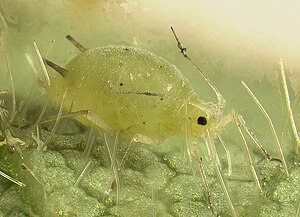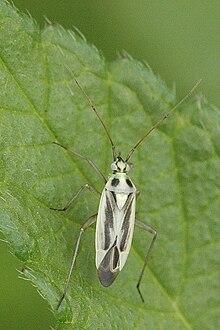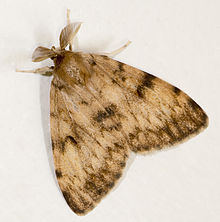Pest insect population dynamics

The population dynamics of pest insects is a subject of interest to farmers, agricultural economists, ecologists, and those concerned with animal welfare.
Factors affecting populations

- Density-independent: Affect a population equally regardless of its density. Examples:[1]
- A winter freeze may kill a constant fraction of potato leafhoppers in a peanut field regardless of the total number of leafhoppers.
- Japanese beetle larvae survive well with lots of summer rain.
- Temperature, humidity, fires, storms, dissolved oxygen for aquatic species.
- Density-dependent: Affect a population more or less as the population is bigger. Examples:[1]
- A bigger population may be more vulnerable to diseases and parasites.
- A bigger population may have more intraspecific competition, while a smaller population may have more interspecific competition.
- Emigration from the population may increase as it becomes more crowded.
Life tables

A life table shows how and how many insects die as they mature from eggs to adults. It helps with pest control by identifying at what life stage pest insects are most vulnerable and how mortality can be increased.[2] A cohort life table tracks organisms through the stages of life, while a static life table shows the distribution of life stages among the population at a single point in time.[3]
Following is an example of a cohort life table based on field data from Vargas and Nishida (1980).[4] The overall mortality rate was 94.8%, but this is probably an underestimate because the study collected the pupae in cups, and these may have protected them from birds, mice, harsh weather, and so on.[4]
| Stage () | Number alive at stage () | Cause of mortality | Number dying | Proportion of original cohort surviving () | Proportion of original cohort dying () | Mortality rate at this step () |
|---|---|---|---|---|---|---|
| Egg | 1000 | Trichogramma confusum wasp parasitism | 386 | 1 | .386 | .386 |
| Egg | 614 | Orius insidiosus predation and unknown | 232 | .614 | .232 | .378 |
| Larva 1 | 382 | O. insidiosus, cannibalism, and unknown | 90 | .382 | .090 | .236 |
| Larva 2 | 292 | Cannibalism and unknown | 59 | .292 | .059 | .202 |
| Larva 3 | 233 | Cannibalism and unknown | 34 | .233 | .034 | .146 |
| Larva 4 | 199 | Cannibalism, disease, parasitism, and unknown | 59 | .199 | .059 | .296 |
| Larva 5 | 140 | Cannibalism, disease, parasitism, and unknown | 69 | .140 | .069 | .493 |
| Larva 6 | 71 | Cannibalism, disease, parasitism, and unknown | 1 | .071 | .001 | .014 |
| Pupa | 70 | Disease and unknown | 18 | .070 | .018 | 0.257 |
| Adult | 52 (28 male, 24 female) | .052 |
Life expectancy
From a life table we can calculate life expectancy as follows. Assume the stages are uniformly spaced. The average proportion of organisms alive at stage between beginning and end is[3]
- .
The total number of future stages to be lived by individuals at age and older is[3]
- .
Then the life expectancy at age is[3]
- .
We could have done the same computation with raw numbers of individuals rather than proportions.
Basic reproductive rate
If we further know the number of eggs produced (fecundity) at age , we can calculate the eggs produced per surviving individual as
- ,
where is the number of individuals alive at that stage.
The basic reproductive rate ,[3] also known as the replacement rate of a population, is the ratio of daughters to mothers. If it's greater than 1, the population is increasing. In a stable population the replacement rate should hover close to 1.[2] We can calculate it from life-table data as[3]
- .
This is because each product computes (first-generation parents at age )/(first-generation eggs) times (second-generation eggs produced by age- parents)/(first-generation parents at age ).
If is the initial population size and is the population size after a generation, then[3]
- .
Generation time
The cohort generation time is the average duration between when a parent is born and when its child is born. If is measured in years, then[3]
- .
Intrinsic rate of increase
If remains relatively stable over generations, we can use it to approximate the intrinsic rate of increase for the population:[3]
- .
This is because
- ,
where the approximation follows from the Mercator series. is a change in time, . Then we have
- ,
which is the discrete definition of the intrinsic rate of increase.
Growth models
In general, population growth roughly follows one of these trends:[1]
- Logistic growth leveling out at some carrying capacity.
- Overshoot ("boom" and "bust" cycles).
- Oscillation at or below the carrying capacity.
Insect pest growth rates are heavily influenced by temperature and rainfall, among other variables. Sometimes pest populations grow rapidly and become outbreaks.[5]
Degree-day calculations
Because insects are ectothermic, "temperature is probably the single most important environmental factor influencing insect behavior, distribution, development, survival, and reproduction."[6] As a result, growing degree-days are commonly used to estimate insect development, often relative to a biofix point,[6] i.e., a biological milestone, such as when the insect comes out of pupation in spring.[7] Degree-days can help with pest control.[8]

Yamamura and Kiritani approximated the development rate as[9]
- ,
with being the current temperature, being the base temperature for the species, and being a thermal constant for the species. A generation is defined as the duration required for the time-integral of to equal 1. Using linear approximations, the authors estimate that if the temperature increased by (for instance, maybe = 2 °C for climate change by 2100 relative to 1990), then the increase in number of generations per year would be[9]
- ,
where is the current annual mean temperature of a location. In particular, the authors suggest that 2 °C warming might lead to, for example, about one extra generation for Lepidoptera, Hemiptera, two extra generations for Diptera, almost three generations for Hymenoptera, and almost five generations for Aphidoidea. These changes in voltinism might happen through biological dispersal and/or natural selection; the authors point to prior examples of each in Japan.[9]
Geometric Brownian motion
Sunding and Zivin model population growth of insect pests as a geometric Brownian motion (GBM) process.[10] The model is stochastic in order to account for the variability of growth rates as a function of external conditions like weather. In particular, if is the current insect population, is the intrinsic growth rate, and is a variance coefficient, the authors assume that
- ,
where is an increment of time, and is an increment of a Wiener process, with being standard-normal distributed. In this model, short-run population changes are dominated by the stochastic term, , but long-run changes are dominated by the trend term, .[10]
After solving this equation, we find that the population at time , , is log-normally distributed:
- ,
where is the initial population.[10]

As a case study, the authors consider mevinphos application on leaf lettuce in Salinas Valley, California, for the purpose of controlling aphids. Previous research by other authors found that daily percentage growth of the green peach aphid could be modeled as an increasing linear function of average daily temperature. Combined with the fact that temperature is normally distributed, this agreed with the GBM equations described above, and the authors derived that and .[10] Since the expected population based on the log-normal distribution grows with , this implies an aphid doubling time of days. Note that other literature has found aphid generation times to lie roughly in the range of 4.7 to 5.8 days.[11]
Repeated outbreak cycles
A 2013 study analyzed population dynamics of the smaller tea tortrix, a moth pest that infests tea plantations, especially in Japan. The data consisted of counts of adult moths captured with light traps every 5–6 days at the Kagoshima tea station in Japan from 1961 to 2012. Peak populations were 100 to 4000 times higher than at their lowest levels. A wavelet decomposition showed a clear, relatively stationary annual cycle in the populations, as well as non-stationary punctuations between late April and early October, representing 4–6 outbreaks per year of this multivoltine species.[12] The cycles result from population overshoot.[13]
These moths have stage-structured development life cycles, and a traditional hypothesis suggests that these cycles should be most synchronized across the population in the spring due to the preceding effects of cold winter months, and as the summer progresses, the life stages become more randomly assorted.[12] This is often what's observed in North America.[13] However, this study observed instead that populations were more correlated as the season progressed, perhaps because temperature fluctuations enforced synchrony. The authors found that when temperatures first increased above about 15 °C (59 °F) in the spring, the population dynamics crossed a Hopf bifurcation from stability to repeated outbreak cycles, until stabilization again in the fall. Above the Hopf threshold, population-cycle amplitude increased roughly linearly with temperature. This study affirmed the classic concept of temperature as a "pacemaker of all vital rates."[12]
Understanding life-cycle dynamics is relevant for pest control because some insecticides only work at one or two life stages of the insect.[13]
Effects of pest control

B. Chaney, a farm advisor in Monterey County, CA, estimates that mevinphos would kill practically all aphids in a field upon application.[10] Wyatt, citing data from various Arthropod Management Tests, estimates that the percent of lettuce aphids killed is 76.1% for endosulfan and 67.0% for imidacloprid.[14]
Insecticides used on gypsy moths in the 1970s had roughly a 90% kill rate.[15]
Impact of climate change
Temperature change is argued to be the biggest direct abiotic impact of climate change on herbivorous insects.[16] In temperate regions, global warming will affect overwintering, and warmer temperatures will extend the summer season, allowing for more growth and reproduction.[16]
A 2013 study estimated that on average, crop pests and pathogens have moved to higher latitudes at a rate of about 2.7 km/year since 1960.[17] This is roughly in line with estimates of the rate of climate change in general.[18]
See also
Notes
- ^ a b c Meyer, John R. (8 Apr 2009). "Population Dynamics". General Entomology course at North Carolina State University. Retrieved 17 June 2014.
- ^ a b Meyer, John R. (8 Apr 2009). "Life Tables". General Entomology course at North Carolina State University. Retrieved 17 June 2014.
- ^ a b c d e f g h i Elzinga, Charles. "Population Biology: Life Tables & Theoretical Populations" (PDF). Laboratory Manual for Honors Organismal Biology. pp. 37–48. Retrieved 17 June 2014.
- ^ a b c Roger Vargas; Toshiyuki Nishida (Feb 1980). "Life table of the corn earworm, Heliothis zea (Boddie), in sweet corn in Hawaii" (PDF). Proceedings, Hawaiian Entomological Society. XXIII (2): 301–307.
- ^ "Insect pest population dynamics". Texas A&M AgriLife Research and Extension Center at Weslaco. Archived from the original on 10 August 2014. Retrieved 16 June 2014.
- ^ a b Curtis Petzoldt; Abby Seaman (2006). "Climate Change Effects on Insects and Pathogens" (PDF). Climate Change and Agriculture: Promoting Practical and Profitable Responses. University of Vermont Extension and New York State College of Agriculture and Life Sciences.
- ^ "Tree Fruit Insect Biofix Dates". Utah Pests. Archived from the original on 17 June 2014. Retrieved 17 June 2014.
- ^ Pruess, Kenneth P. (1 Jun 1983). "Day-degree Methods for Pest Management". Environmental Entomology. 12 (3): 613–619. doi:10.1093/ee/12.3.613.
- ^ a b c Kohji Yamamura; Keizi Kiritani (1998). "A simple method to estimate the potential increase in the number of generations under global warming in temperate zones". Applied Entomology and Zoology. 33 (2): 289–298. Bibcode:1998AppEZ..33..289Y. doi:10.1303/aez.33.289.
- ^ a b c d e David Sunding; Joshua Zivin (Aug 2000). "Insect population dynamics, pesticide use, and farmworker health". American Journal of Agricultural Economics. 82 (3): 527–540. doi:10.1111/0002-9092.00044. S2CID 12938719.
- ^ Li, Tang (8 May 1995). "Chapter 6: Shortest Generation Time". The University of Florida Book of Insect Records. Retrieved 16 June 2014.
- ^ a b c William A. Nelson; Ottar N. Bjørnstad; Takehiko Yamanaka (16 Aug 2013). "Recurrent Insect Outbreaks Caused by Temperature-Driven Changes in System Stability". Science. 341 (6147): 796–799. Bibcode:2013Sci...341..796N. doi:10.1126/science.1238477. PMID 23907532. S2CID 206549137.
- ^ a b c Messer, A'ndrea Elyse (1 Aug 2013). "Temperature alters population dynamics of common plant pests". Penn State News. Retrieved 17 June 2014.
- ^ Wyatt, T. J. (28–31 July 2002). "Insect population dynamics, pesticide use and farmworker health revisited: Pesticide choice and risk mitigation" (PDF). Paper selected for presentation at the annual meetings of the American Agricultural Economics Association.
- ^ Michael H. Gerardi; James K. Grimm (May 1979). The History, Biology, Damage, and Control of the Gypsy Moth, Porthetria Dispar (L.). Cranbury, NJ: Associated University Presses. p. 129. ISBN 978-0838620236.
- ^ a b Jeffery S. Bale; Gregory J. Masters; Ian D. Hodkinson; Caroline Awmack; T. Martijn Bezemer; Valerie K. Brown; Jennifer Butterfield; Alan Buse; John C. Coulson; John Farrar; John E. G. Good; Richard Harrington; Susane Hartley; T. Hefin Jones; Richard L. Lindroth; Malcolm C. Press; Ilias Symrnioudis; Allan D. Watt; John B. Whittaker (23 Jan 2002). "Herbivory in global climate change research: direct effects of rising temperature on insect herbivores". Global Change Biology. 8 (1): 1–16. Bibcode:2002GCBio...8....1B. doi:10.1046/j.1365-2486.2002.00451.x. S2CID 86258707.
- ^ Daniel P. Bebber; Mark A. T. Ramotowski; Sarah J. Gurr (1 Sep 2013). "Crop pests and pathogens move polewards in a warming world". Nature Climate Change. 3 (11): 985–988. Bibcode:2013NatCC...3..985B. doi:10.1038/nclimate1990.
- ^ Barford, Eliot (1 Sep 2013). "Crop pests advancing with global warming". Nature. Nature News. doi:10.1038/nature.2013.13644. Retrieved 17 June 2014.




















































